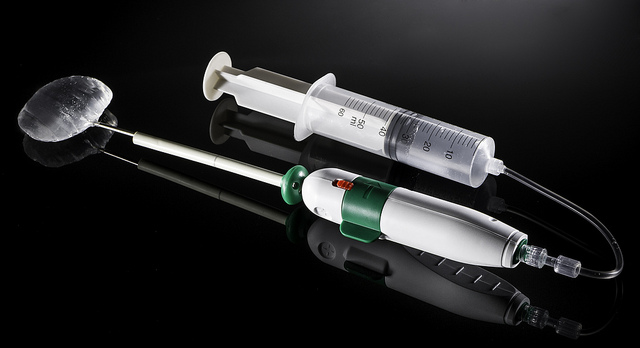The ball spacer OrthoSpace
The spacer ball OrthoSpace is an art technique, shown in partial or complete tendon tears, performing at 10 minutes is a viable alternative to complicated surgery.
The technique consists of implanting a ball biodegradable material in the interior of a joint. The ball creates a space between the bones which friction causes pain. By reducing the pain the body can recover faster than other surgeries.
The implantation is performed using a minimally invasive procedure, in outpatient setting and in a short space of time. No need to go into hospital.
The ball simulates the normal action of the bursa (synovial fluid bag that prevents friction between muscles, tendons and bones of the joint and acts as a buffer), con lo que disminuye el dolor del paciente y se reduce el tiempo de rehabilitación. Al ser biodegradable no se requiere ninguna intervención posterior para retirar el balón.
Indications (to learn more)
When the tendons or muscles break, plus experience pain, range of motion is limited. The pain radiates from breaking into the affected limb. A complete tear of tendons or muscles will not heal spontaneously, usually need surgery. Sometimes the condition of the tendon or muscle repair does not allow.
The spacer ball is a biodegradable polymer widely used in medicine, creating a space between the bones and prevents friction and friction between bones. The ball reduces pain and dissolves gradually in the course of a year.
The spacer ball is approved by the European authorities since July 2010.
Is introduced into the joint through a local anesthetic arthroscopy.
Recovery
After implantation of a spacer ball patients should avoid quick movements and sudden, repetitive, lifting weights or doing exercises that require much effort. Also, el paciente deberá seguir el programa de ejercicios de rehabilitación marcado por su cirujano o por su fisioterapeuta, to recover the satisfactory operation of the joint.
Precautions
The risks of this procedure are the same as those of any arthroscopy: swelling, pain, nerve injury, infection, restricted movement or discomfort.
Allergic reactions occur in less than one 5% patients. When this happens, the orthopedic surgeon decides whether to deflate through a needle, remove arthroscopically, or leave until their reabsorption occurs.
Contraindications
- Latent or active infection and signs of necrosis in tissue.
- Allergy polymer ball (polylactic-co-glycolide-caprolactone and).
- The surgeon will consider clotting disorders or immune system, chronic diseases such as heart disease, cirrhosis, chronic renal failure or any other that might compromise the implementation.

